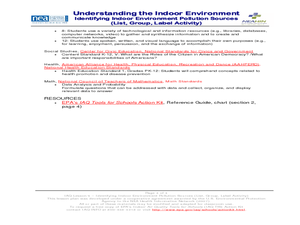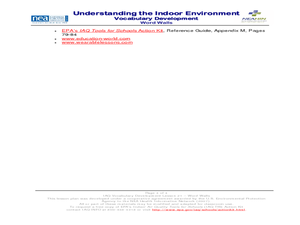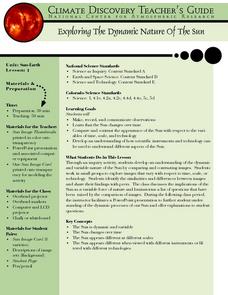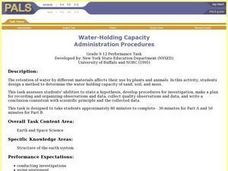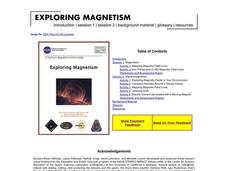Curated OER
Identifying Indoor Environment Pollution Sources (List, Group, Label Activity)
Students identify the cause of indoor air pollution. In this indoor air pollution lesson, students list, group, and label sources of indoor pollution. They brainstorm a list of all of the indoor pollutants they can think of before...
Curated OER
Understanding the Indoor Environment:Preventing and Fixing Indoor Air Pollution
Students explore air pollution. In this environmental studies lesson, students work with a partner to create a Venn diagram comparing and contrasting possible solutions to prevalent indoor air pollution problems. Students discuss and...
Curated OER
Invention Project
Students study air pollution and design inventions to prevent indoor environment problems. In this air pollution inventions lesson, students read about and discuss famous inventors and inventions. Students then research indoor air...
Curated OER
Deck of Word Cards
Learners study vocabulary words associated with indoor air quality. In this air quality lesson, students participate in a word card game where they write sentences for the vocabulary words given. Learners then check the original teacher...
Curated OER
Indoor Air Quality
Students make a work puzzle using air quality vocabulary. In this air quality vocabulary instructional activity, students design a word puzzle using a teacher designated number of vocabulary words. They peer edit the puzzles with their...
Curated OER
Understanding the Indoor Environment: Word Walls
Students study vocabulary words about indoor air quality. In this indoor environment lesson, students create a word wall with vocabulary words about indoor air quality and pollutants.
Curated OER
To Spread or Not to Spread
Students explore the difference between the three types of contrails. In this contrails instructional activity, students make observations of contrails and record them. Students identify the three types of contrails and complete an...
Curated OER
Earthquake Epicenters and Magnitudes
Students work on a virtual earthquake to increase their understanding of seismograms, earthquake epicenters, Richter Magnitude and triangulation when finding the epicenter of an earthquake.
Curated OER
Exploring the Dynamic Nature of the Sun
Students compare and contrast images of the sun taken at different times and viewed at different scales. They record their observations in a journal and create a graphic organizer to help analyze their observations.
Curated OER
Water-Holding Capacity
Students design and conduct an experiment to compare the water-holding capacity of sand, soil, and moss. They measure the change in weight for each material after adding the same amount of water to each material.
Curated OER
Pattern
Students describe examples of the relationship between structure and function in living systems, particularly with regard to specialized tissues and organs. They describe examples of biological diversity and adaptation of organisms with...
Curated OER
Climate change in Canada
Students investigate the impact of human activity on the environment. In this secondary math/science lesson, students analyze and interpret information from data and graphs as they investigate trends in climate change and the reasons...
Curated OER
The Blizzard of 1993
Students read and interpret the information from a barograph from a major winter storm. This task assesses students' abilities to interpret and analyze graphs, construct data tables and graphs, generalize, infer, apply knowledge of...
Curated OER
Formation of Wind
Young scholars correctly sequence the steps leading to the formation of wind, and describe the cause and effect relationships involved in the formation of wind. This task assesses students' abilities to classify, generalize, infer,...
Curated OER
Exploring Magnetism
Students participate in several activities that allow them to better understand magnetism. In this exploratory lesson students take part in different activities to help them to better understand magnetic fields, circuits and...
Curated OER
Tree Identification
Students list four ways to identify trees. In this tree identification instructional activity, students use tree identification techniques such as leafs, bark, wood grain, soil type, and climate to create tables and graphs.
Curated OER
Living During the Little Ice Age
Students brainstorm what living conditions during the period known as the Little Ice Age (1350-1850) might have been like. They research lifestyles, the economy, crop yields, and human and livestock mortality.
Curated OER
Where Have All the Glaciers Gone?
Fourth graders discover that scientists examine evidence from around the world in order to explain global climate change. They see that records of climate change exist, and describe photographs interpreting changes in glaciers over time.
Curated OER
Blooming Thermometers
Students study phenology, or the study of climate change. They research the Japanese springtime festival of Hanami and plot and interpret average cherry blossom bloom date data from the past 1100 years.
Curated OER
Sun and Temperatures
Students consider the relationship of temperature to environmental conditions and then apply their knowledge to a practical event. The task assesses students' knowledge and application of that knowledge to an additional situation.
Curated OER
Warm and Toasty
Students are introduced to the concepts of specific heat and heat capacity. In groups, they design an experiment to test these two topics on various fabrics. They compare and contrast the amount of heat loss on the different materials...
Curated OER
Aging of Trees
Students examine tree rings to determine its age. In this tree ring lesson, students examine core tree samples, identify the tree rings, and then determine its age. Students complete a worksheet, deciding which of the two core sample is...
Curated OER
Interdisciplinary Task: Weather
Students design a chart to use to record the weather for five days. They then build an anemometer to record wind speed and discover why they are used for this purpose.
Curated OER
Clouds and the Weather
Fourth graders analyze the relationship of clouds and local weather. Students also observe and record cloud data and weather conditions daily as they research different cloud types. The data is analyzed looking for trends in daily...


